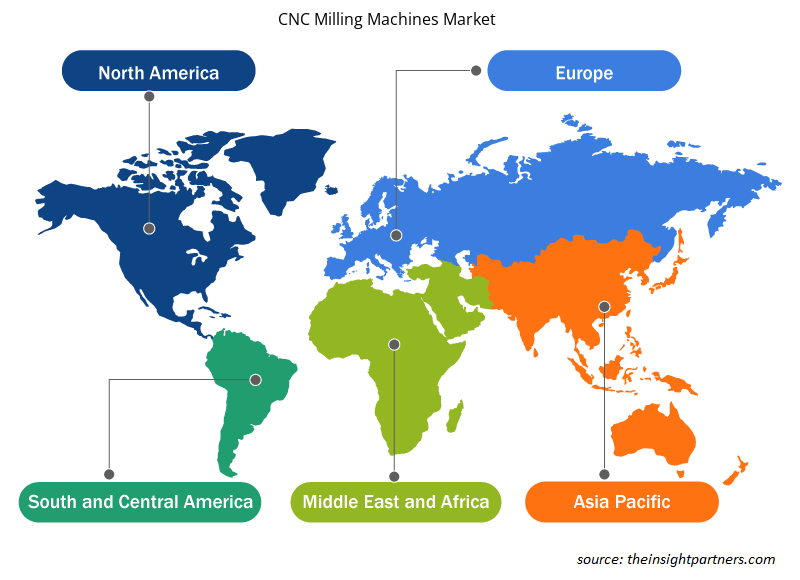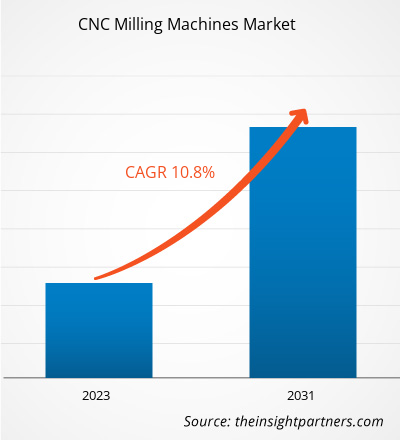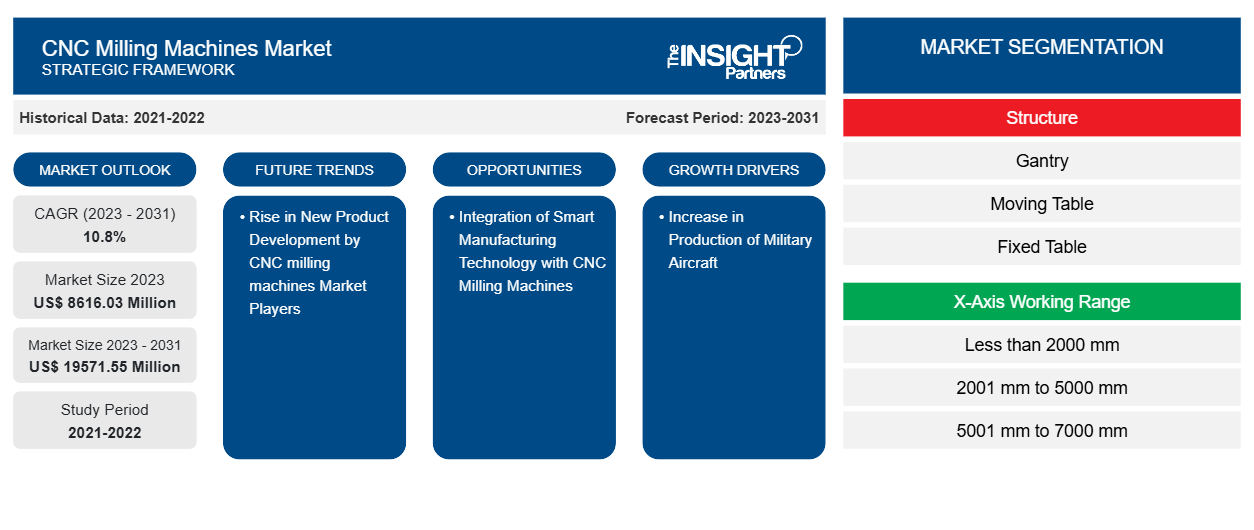Der Markt für CNC-Fräsmaschinen soll von 8.616,03 Millionen US-Dollar im Jahr 2023 auf 19.571,55 Millionen US-Dollar im Jahr 2031 anwachsen. Der Markt soll in den Jahren 2023–2031 eine durchschnittliche jährliche Wachstumsrate (CAGR) von 10,8 % verzeichnen. Die weltweit steigende Nachfrage nach Elektrofahrzeugen treibt die Automobilindustrie stark an. Die Automobilindustrie weltweit erlebt erhebliche Veränderungen, beispielsweise eine steigende Produktion von Elektrofahrzeugen und autonomen Fahrzeugen. Viele Automobilhersteller haben ihre Produktion durch die Einführung von Automatisierung und die Erweiterung von Produktionsstätten auf der ganzen Welt gesteigert. Laut der Internationalen Energieagentur (IEA) haben sich die Verkäufe von Elektrofahrzeugen (EV) im Jahr 2021 im Vergleich zu 2020 fast verdoppelt, und das trotz Engpässen in der Lieferkette und der COVID-19-Pandemie. Im Jahr 2021 wurden fast 6,6 Millionen Elektrofahrzeuge verkauft, und weltweit waren insgesamt 16,5 Millionen Elektrofahrzeuge auf den Straßen unterwegs. Im Jahr 2021 wurden in China 3,3 Millionen Elektrofahrzeuge verkauft, verglichen mit 1,2 Millionen im Jahr 2020. Die Automobilindustrie ist einer der größten Anwender von CNC-Fräsmaschinen. In der Automobilindustrie fertigen CNC-Fräsmaschinen Innenverkleidungen, Antriebsmotoren und verschiedene Sonderteile. Die CNC-Bearbeitung hilft der Automobilindustrie auch bei der Entwicklung funktionsfähiger Prototypen, die nach Tests und Validierung in die Massenproduktion gehen können. Das Wachstum der Automobilindustrie treibt also in erster Linie den Markt für CNC-Fräsmaschinen an.
Marktanalyse für CNC-Fräsmaschinen
Die Automobilindustrie weltweit erlebt erhebliche Veränderungen, wie beispielsweise einen Anstieg der Produktion von Elektrofahrzeugen und autonomen Fahrzeugen. Viele Automobilhersteller haben ihre Produktion durch die Einführung von Automatisierung und die Erweiterung von Produktionsstätten auf der ganzen Welt gesteigert. Im Folgenden sind einige der in den letzten Jahren eröffneten neuen Produktionsstätten aufgeführt:
- Im September 2021 gab Ford die Eröffnung seines neuen Werks zur Produktion von Elektrofahrzeugen in den USA mit einer Investition von 11,4 Milliarden US-Dollar bekannt.
- Im September 2022 eröffnete Continental mit einer Investition von 110 Millionen US-Dollar sein neues Automobilproduktionswerk in Texas.
- Im Oktober 2021 gab Nissan die Eröffnung seines neuen Produktionswerks in Tochigi bekannt. Das Werk ist mit der Herstellung von Fahrzeugen der nächsten Generation beschäftigt, um CO2-Neutralität zu erreichen.
Die Eröffnung neuer Produktionsstätten auf der ganzen Welt trägt zum Anstieg der Fahrzeugproduktion bei. Der Anstieg der Fahrzeugproduktion in Einheiten in einigen Ländern im Jahr 2022 im Vergleich zu 2021 ist nachstehend aufgeführt:
|
Land
|
2021
|
2022
|
% ändern
|
|
Vereinigte Staaten
|
9.167.214 |
10.060.339 |
10 % |
|
Deutschland
|
3.308.692 |
3.677.820 |
11 % |
|
China
|
26.082.220 |
27.020.615 |
3 % |
|
Indien
|
4.399.112 |
5.456.857 |
24 % |
|
Indonesien
|
1.121.967 |
1.470.146 |
31 % |
|
Südafrika
|
499.087 |
555.889 |
11 % |
|
Argentinien
|
434.753 |
536.893 |
24 % |
Quelle: Internationale Organisation der Kraftfahrzeughersteller
CNC-Fräsmaschinen werden häufig in der Automobilproduktion eingesetzt, einschließlich der Herstellung verschiedener Teile wie Innenverkleidungen, Getriebe, Sonderteile und Motoren. Die weltweit wachsende Automobilproduktion treibt daher die Nachfrage nach CNC-Fräsmaschinen an und trägt so zum Wachstum des Marktes für CNC-Fräsmaschinen bei.
Marktübersicht für CNC-Fräsmaschinen
Computergesteuerte CNC-Fräsmaschinen (Computerized Numerical Control) sind die wichtigsten Maschinen für die subtraktive Fertigung, bei der Material vom Werkstück entfernt wird, um ein fertiges Produkt zu erzeugen. Dies unterscheidet sich von additiven Fertigungsverfahren wie 3D-Druck, Gießen oder Spritzgießen, bei denen Material hinzugefügt wird, um ein fertiges Produkt zu erzeugen. Der Prozess beginnt mit einer zwei- oder dreidimensionalen computergestützten Konstruktionsdarstellung (CAD) des zu fertigenden Teils. CAD leitet den Schneidprozess des Werkstücks und definiert die Maße und Anforderungen für das Teil genau. CNC-Fräsen war der erste CNC-Prozesstyp, der 1952 verwendet wurde und verschiedene Materialien wie Metall, Glas, Legierung, Kunststoff oder Holz umformen kann. Es ist das am häufigsten verwendete CNC-Verfahren und kann so programmiert werden, dass kundenspezifische Teile nach genauen und genauen Spezifikationen hergestellt werden. Derzeit bieten viele Marktteilnehmer eine breite Produktpalette mit verschiedenen Spezifikationen, Größen und Funktionen an.
Passen Sie diesen Bericht Ihren Anforderungen an
Sie erhalten kostenlose Anpassungen an jedem Bericht, einschließlich Teilen dieses Berichts oder einer Analyse auf Länderebene, eines Excel-Datenpakets sowie tolle Angebote und Rabatte für Start-ups und Universitäten.
-
Holen Sie sich die wichtigsten Markttrends aus diesem Bericht.Dieses KOSTENLOSE Beispiel umfasst eine Datenanalyse von Markttrends bis hin zu Schätzungen und Prognosen.
Regionale Einblicke in den Markt für CNC-Fräsmaschinen
Die regionalen Trends und Faktoren, die den Markt für CNC-Fräsmaschinen im Prognosezeitraum beeinflussen, wurden von den Analysten von Insight Partners ausführlich erläutert. In diesem Abschnitt werden auch die Marktsegmente und die Geografie von CNC-Fräsmaschinen in Nordamerika, Europa, im asiatisch-pazifischen Raum, im Nahen Osten und Afrika sowie in Süd- und Mittelamerika erörtert.

- Holen Sie sich die regionalen Daten für den Markt für CNC-Fräsmaschinen
Umfang des Marktberichts zu CNC-Fräsmaschinen
| Berichtsattribut | Details |
|---|---|
| Marktgröße im Jahr 2023 | 8616,03 Millionen US-Dollar |
| Marktgröße bis 2031 | 19571,55 Millionen US-Dollar |
| Globale CAGR (2023 - 2031) | 10,8 % |
| Historische Daten | 2021-2022 |
| Prognosezeitraum | 2023–2031 |
| Abgedeckte Segmente |
Nach Struktur
|
| Abgedeckte Regionen und Länder |
Nordamerika
|
| Marktführer und wichtige Unternehmensprofile |
|
Marktteilnehmerdichte: Der Einfluss auf die Geschäftsdynamik
Der Markt für CNC-Fräsmaschinen wächst rasant, angetrieben durch die steigende Nachfrage der Endnutzer aufgrund von Faktoren wie sich entwickelnden Verbraucherpräferenzen, technologischen Fortschritten und einem größeren Bewusstsein für die Vorteile des Produkts. Mit steigender Nachfrage erweitern Unternehmen ihr Angebot, entwickeln Innovationen, um die Bedürfnisse der Verbraucher zu erfüllen, und nutzen neue Trends, was das Marktwachstum weiter ankurbelt.
Die Marktteilnehmerdichte bezieht sich auf die Verteilung der Firmen oder Unternehmen, die in einem bestimmten Markt oder einer bestimmten Branche tätig sind. Sie gibt an, wie viele Wettbewerber (Marktteilnehmer) in einem bestimmten Marktraum im Verhältnis zu seiner Größe oder seinem gesamten Marktwert präsent sind.
Die wichtigsten auf dem Markt für CNC-Fräsmaschinen tätigen Unternehmen sind:
- Okuma Corporation
- Nidec Corporation
- NICOLÁS CORREA
- SA
- AWEA MECHANTRONIC CO., Ltd
- EMCO GmbH
Haftungsausschluss : Die oben aufgeführten Unternehmen sind nicht in einer bestimmten Reihenfolge aufgeführt.

- Erhalten Sie einen Überblick über die wichtigsten Akteure auf dem Markt für CNC-Fräsmaschinen
Marktnachrichten und aktuelle Entwicklungen zu CNC-Fräsmaschinen
Der Markt für CNC-Fräsmaschinen wird durch die Erhebung qualitativer und quantitativer Daten nach Primär- und Sekundärforschung bewertet, die wichtige Unternehmensveröffentlichungen, Verbandsdaten und Datenbanken umfasst. Im Folgenden finden Sie eine Liste der Entwicklungen auf dem Markt für Innovationen, Geschäftserweiterungen und Strategien:
- Im Januar 2023 machen sich EMCO und GLM auf den Weg zur EMCO GLM GMBH. Nach einer sehr erfolgreichen Vorbereitungsphase, in der die Zusammenarbeit der beiden Unternehmen in den Bereichen Vertrieb, Anwendungstechnik, Automatisierung und Service bereits gut angelaufen ist, wurde die Gründung der neuen Gesellschaft EMCO GLM GmbH, mit einer Mehrheitsbeteiligung von EMCO, eingeleitet. (Quelle: EMCO, Pressemitteilung)
- Im Dezember 2022 hat TRIMILL erfolgreich eine 5-achsige Fräsmaschine TRIMILL VFC 3021 an einen Kunden in Deutschland ausgeliefert. Die Fräsmaschine ist mit einem 2-achsigen Gabelfräskopf T21C ausgestattet, der für kontinuierliches Fräsen ausgelegt ist und hohe Präzision und Steifigkeit bietet. TRIMILL behauptet, seinen Kunden qualitativ hochwertige und maßgeschneiderte Fräslösungen anzubieten, sowie die Fähigkeit, Maschinen weltweit erfolgreich auszuliefern und zu installieren. (Quelle: TRIMILL, Pressemitteilung)
Marktbericht zu CNC-Fräsmaschinen – Umfang und Ergebnisse
Der Bericht „Marktgröße und Prognose für CNC-Fräsmaschinen (2021–2031)“ bietet eine detaillierte Analyse des Marktes, die die folgenden Bereiche abdeckt:
- Marktgröße und Prognose für CNC-Fräsmaschinen auf globaler, regionaler und Länderebene für alle abgedeckten wichtigen Marktsegmente.
- Marktdynamik wie Treiber, Beschränkungen und wichtige Chancen
- Markttrends für CNC-Fräsmaschinen
- Detaillierte PEST/Porters Five Forces- und SWOT-Analyse
- Marktanalyse für CNC-Fräsmaschinen mit Abdeckung der wichtigsten Markttrends, globaler und regionaler Rahmenbedingungen, wichtiger Akteure, Vorschriften und aktueller Marktentwicklungen
- Marktlandschaft und Wettbewerbsanalyse für CNC-Fräsmaschinen, einschließlich Marktkonzentration, Heatmap-Analyse, prominenten Akteuren und aktuellen Entwicklungen.
- Detaillierte Firmenprofile
- Historische Analyse (2 Jahre), Basisjahr, Prognose (7 Jahre) mit CAGR
- PEST- und SWOT-Analyse
- Marktgröße Wert/Volumen – Global, Regional, Land
- Branchen- und Wettbewerbslandschaft
- Excel-Datensatz
Aktuelle Berichte
Erfahrungsberichte
Grund zum Kauf
- Fundierte Entscheidungsfindung
- Marktdynamik verstehen
- Wettbewerbsanalyse
- Kundeneinblicke
- Marktprognosen
- Risikominimierung
- Strategische Planung
- Investitionsbegründung
- Identifizierung neuer Märkte
- Verbesserung von Marketingstrategien
- Steigerung der Betriebseffizienz
- Anpassung an regulatorische Trends























 Kostenlose Probe anfordern für - Markt für CNC-Fräsmaschinen
Kostenlose Probe anfordern für - Markt für CNC-Fräsmaschinen